Introduction
Charles Ives was an American modernist composer born in 1874 and died on 1954. Ives is recognized to be present day due to the innovations he did that led to musical developments in 20th Century. One of the most recognized pieces by Ives is "The Unanswered Question" which was done in 1908, where the major element applied in the compositions was spatial separation. The instruments that are used when the piece is being played are a solo trumpet, woodwind quarter and a string ensemble. The following work will show the musical elements of "The Unanswered Question" piece and how answers alternated with the questions in the orchestra.
"The Unanswered Question" can be termed as program music, with the musical instruments having clear roles in the musical piece such as musical language, articulation, and ensuring that each question has been answered as expected. One of the interesting things about the musical is the way instruments have been replaced, for instance, flute II has been replaced with the oboe can, while the clarinet can replace flute IV. The clarinet, oboe, and English horn can also be replaced by the trumpet. The replacements result in a difference in sound, thus making the substitutions dramatic since there are other instruments which could have made the sound remain such as a recorder or piccolo. The way the instruments are substituted is an indication that the orchestration was lean during that period (Music11).
C major is the starting key of the "The Unanswered Question" piece and is in the 4/4 meter, with a very slow tempo. The part of the strings are playing very softly as the musical begins, thus creating the effect of sorrow or sadness. In the strings parts, there are different tied notes, which ranges from one to fifteen and they sound very quiet. It is as if the musical is describing something taking place at night. The background music, as well as the strings, is creating a pattern, where the tied notes are played throughout the piece. The part in the music being played is describing the druids who are considered silent as they cannot hear or see anything.
As "The Unanswered Question" continues to play, the trumpet begins to play softly, which follows a slow harmonic rhythm. The measure of the notes was sixteen, half and a quarter formed the question and when the play is being made, forms the question. Since the part is retrieved from the original texture, it sounded very isolated. The part of the piece also separates the entire musical ensuring that only the string parts are playing. In the eighteenth measure, the string parts go on playing the tied notes, until the 19th measure where the flutes quartet joins in and the tied notes and triplets are played together (Music11). The musical instruments play in slow tempo and the flutes sound as if they are looking for answers. The background music continues to play as the string parts do not stop. The trump joins in the other musicals in measure 23, sounding like a question, using the rhythmic patterns played in 16 and 17 measures.
The articulation of the question in the musical piece starts on different beats in the entire "The Unanswered Question." In the first beat, the sixteenth measure is where the question motive can be noted and then proceeds to beat three in the twenty-third measure. The question motive can starts on beat two in measure 31. The difference in the beats indicated rhythmic displacement thus showing differences in piece movements. It has made the piece interesting with the displacement, and if it were not there, the piece would be sounding stagnant due to repetition and moving too slow in the string section.
The musical piece grows louder as the playing continuous, especially the flute part which presents the tempo of the answer. The change in how fast the piece is being played indicates the anxiety in establishing the answer to the questions. The flute parts then play together in unison in measure 26, which sounds like they all discovered the answer at the same time (Music11). In measure 34, the flutes start to have different beats, which indicates that there is a disagreement on the answer. In measure 38, there is another question motive appearing, and it is played on the trumpet softly. As the flutes provide an answer to the question, the play louder in comparison to other parts. The string section which is almost the piano created a difference in the string and the flutes parts.
Conclusion
In conclusion, "The Unanswered Question" combined different instruments, thus creating different emotions, making it a great piece. The trump is used to represent the questions while the flute provides the answers, as it keeps on changing the dynamic and the tempo. Instead of presenting the questions and answers in a musical manner, many dissonances between the woodwind and the trumpet are noted. The changes in the musical elements are to show that there is a struggle to get the answers.
Work Cited
Music11, Classical. "Charles Ives - The Unanswered Question." YouTube, YouTube, 7 Apr. 2014, www.youtube.com/watch?v=vXD4tIp59L0.
Cite this page
Essay Sample on Charles Ives: The Unanswered Question. (2022, Oct 23). Retrieved from https://midtermguru.com/essays/essay-sample-on-charles-ives-the-unanswered-question
If you are the original author of this essay and no longer wish to have it published on the midtermguru.com website, please click below to request its removal:
- Extended Definition of Good Writing - Paper Example
- Essay on Fear the Walking Dead: The Good Man Episode
- Analysis of Kurosawa's "Dreams" and Jim Jarmusch's "Coffee and Cigarettes"
- Movie Analysis Essay on The Wizard of Oz
- Paper Example on Media's Positive Effect on the LGBTQ Community
- Essay Sample on Tintoretto's 'Last Supper'
- Movie Analysis Essay on Real Women Have Curves







